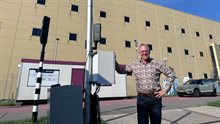Solutions in mobility with 6G
In the FNS partner interviews, we feature a partner every week. Our partners give insight into developments and innovations within their organisation and their role at 6G Future Network Services.
The Future Mobility Network (FMN) - a spin-off of TU Delft - is committed to realising sustainable mobility solutions for the future through connection, advice, development and research of innovative methods. Mobility of both people and goods, on land, at sea and in the air. How will we transport ourselves and our goods in 5, 10 or 20 years' time? That is one of the issues they deal with every day.
We spoke with Joop Veenis, one of the founders of FMN. Joop proudly talks about FMN's various mobility solutions: "From self-driving shuttles for the last mile, hubs, city logistics, sustainable area developments to traffic solutions and freight transport by drone or robot, we make it possible. We take on huge tasks around disruption projects such as the Van Brienenoord Bridge. We also manage various innovative mobility solutions, from shared cars to a ferry that can sail automatically. From FMN, we develop all these kinds of innovative products."
Technology of the future
FMN bridges the needs of governments, such as in mobility management and traffic management, often as part of an area development. In FNS, they bring that knowledge of users' and managers' needs and intertwine developments in the work fields with the development of 6G. They do this in program line 3 in the Wireless Detection work package, where, in collaboration with Vialis and the municipality of Rotterdam, among others, they design the smart intersection and, based on the use of intelligent Traffic Control Installation (iVRI), investigate to what extent the current detection loops in the road can be replaced by wireless detection based on 6G.

Detection possible with 6G
Physical infrastructure such as roads, intersections, hubs and ports is also digitising. Without people in the vehicle, vessel or aircraft, the first steps are often remote control. Familiar from bridges and locks, but now also applicable to shared cars and logistics robots. Without reliable, communicative infrastructure, these connected, automated systems are not safe. Communication with the user and logistics chain also depends on reliable and fast communication. Joop explains: "With 5G, we already saw the speed increase and slicing offered a way to avoid delays on congested networks. With 6G, we are entering the next development and we are coming to a different frequency, where object detection can become part of the digital infrastructure. 6G will become the basis for future solutions in mobility."
Triple jump
FMN advises and realises mobility solutions with governments and companies, including when it comes to shaping the digital infrastructure. "This has to be done step by step," Joop explains. "We always start with testing first, trying things out together so we don't get any new surprises and then we can introduce new things with a good feeling, following the triple jump principle. First testing in a safe environment (test site), then testing 'outside' with municipalities and users and, as a final step, scaling up further. In this way, innovative knowledge of new mobility emerges, prototypes can mature, use can be scaled up by companies and public safety can be regulated by governments. This is also the reason FMN started the Future Mobility Park Foundation (SFMP) with various governments and knowledge institutes."
Future Mobility Park Foundation: testing - demo - learning
SFMP acts as a living lab where companies, research institutes and governments can work together to design, test and implement new technologies and concepts in the field of mobility. A place for inspiration, meeting, testing and research around innovative mobility. Governments, companies, educational and knowledge institutions come and work together for a better future. Automated vehicles are tested (delivery robots, remote-controlled shared cars, vending robots, ferries, buses and shuttles), AI cameras tested for safety, it provides a home to one of the Hardt Hyperloop tubes and there is a control room for remote operations and monitoring. Tours and challenges are also organised for schoolchildren and students.
Wireless sensing and the smart intersection
Within FNS, SFMP facilitates field testing with wireless sensing and prepares scale-up from the requirements, practical design and operational and safety frameworks in mobility. SFMP manages a high-tech test site in Rotterdam and supports the ecosystem for new mobility in which companies, governments and knowledge institutions cooperate and gain experience at FMP and share it with each other. In terms of digital infrastructure, SFMP has hybrid networks with wireless connections and fibreglass, and the intersections are smart with iVRIs as used and managed by municipalities in cooperation with market parties. SFMP has sponsors (Municipality of Rotterdam and MRDH) and partners (Connekt and CROW) to share knowledge.
Future
"We want to innovate not only from technology, but also from application," Joop concludes. "Step by step, with the right stakeholders, trying things out to learn from. We are really still in the early stages when it comes to 6G. FMN and SFMP can start facilitating that transition from 5G to 6G, but it will take years. Longer than you think."
